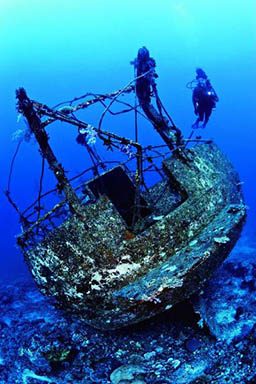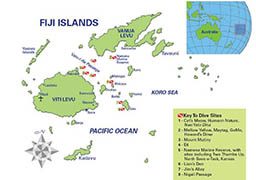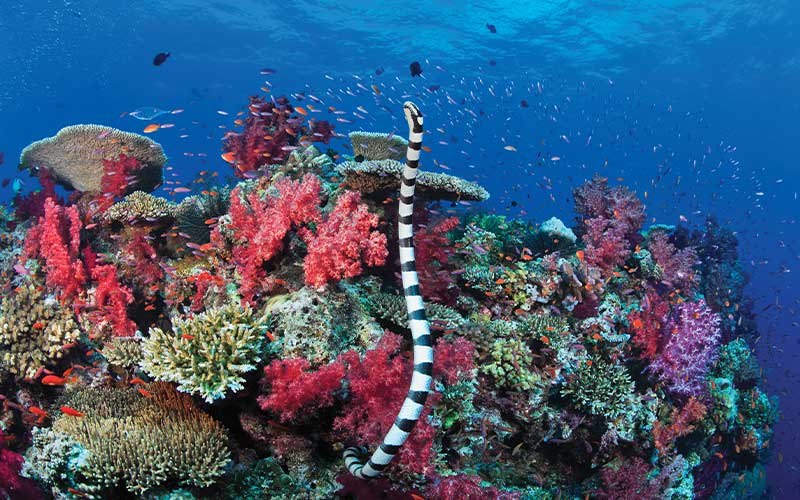Through the ocean’s wavy window, we could see the sky — the same sky that was falling. According to the 24-hour news networks, the global meltdown had begun. Our retirements were trashed, nations were at war, climate was changing and the environment was lost. The world had gone mad.
That world was only 30 ft (9 m) away, but it felt like a million miles. Here in the blue water of central Fiji, everything was as it should be. The exquisitely landscaped coral garden known as Mellow Yellow certainly never looked better. In tables and mounds, fingered clusters and spiky branches, each coral colony seemed to outdo the next in shape and texture. Overhead, a heavy cloud of orange and purple anthias, hundreds strong, quivered in the current, and the wall beneath us was carpeted in glorious yellow soft corals. Marauding jacks streaked through a river of baitfish, each charge creating a hollow, thumping “whoompf!” as the school collapsed and turned to escape. We could feel the reef’s pulse. It was alive and well.
Better Than Ever

When I heard through the online grapevine that Fiji’s coral reefs were healthier now than a decade ago, it struck me as improbable, considering all of the challenges facing the marine environment these days. Daring to hope it was true, my wife, Melissa, and I decided to find out. We signed on to an extended liveaboard cruise of the Lomaiviti Group, a collection of bommies and barrier reefs, islands, seamounts and deep-sea trenches. Beginning in the Bligh Waters of the Vatu-I-Ra Passage, extending northeast to Namena and southeast to Gau, this area of central Fiji consistently delivers what many divers consider to be the best, most diverse diving in the entire island nation.
Take Howard’s Diner, for example. This stunning reef is named after filmmaker Howard Hall, who missed many a meal here while shooting the IMAX film “Coral Reef Adventure.” With forever-visibility and the sea a flat calm, we were entranced from the second we entered the water. Ignoring the seductive call of the deep, we spent the next 90 minutes in 3 ft (1 m) of water snapping pictures of the pastel mirage painted by healthy hard corals projected in the perfect mirror image on the water’s surface.
Fiji is also well known for the multi-hued brilliance of the Dendronephthya soft corals. Case in point: GoMo, a reef on the edge of the Vatu-I-Ra Passage. In water with 100-ft (30-m) visibility, we happily descended to lose sight of each other in a thick cloud of anthias at 30 ft (9 m). Our briefing had warned of “soft corals galore,” so I was ready for what came next. Well, not exactly.
The reef was an explosion of Dendronephthya in every color imaginable, sea fans in persimmon and gold, wire corals in chartreuse and bushes of black coral in burnt umber. Fearing retinal burn, I turned away from the wall to look out into the blue, where a procession of bannerfish, followed by a lunker dogtooth tuna, swam by. Before the dive was over, I found myself shooting away at a monstrous, muscular school of mackerel tuna that spiraled into a ball before plunging down the reef face.
Current Affairs

Current is the lifeblood coursing through the veins of the Lomaiviti reef system. It feeds the fish and inflates soft corals. It flushes out lagoons and brings in clear oceanic water. Future generations of reef inhabitants arrive on scene thanks to currents — Fiji is the first major reef system encountered by tiny larval fish and invertebrate spawn drifting in from all across the Pacific. Eager to settle down, they adhere to any available solid structure and start growing.
According to Rob Barrel, Fiji diving pioneer and owner of the Nai’a liveaboard, “Our dive sites have never been heavily fished and are too far offshore to be affected by run-off.” He added, “Fiji’s reefs also have been spared large-scale damage from natural causes like cyclones, and the vast majority of the reefs that we’re diving are thankfully free of most manmade harassment.”
The days began to blur pleasantly together with visits to sites like Cat’s Meow and Humann Nature, two compact pinnacles offering a riot of color on top and interesting critters on the sides and bottom. Up until now, I had been seeing it all through the 180-degree view of my fisheye lens, thereby overlooking countless undersized wonders. So I switched to macro and zeroed in on lionfish, butterflyfish, angels and, of course, Nemo himself. There’s something therapeutic about the struggle to photograph spunky clownfish as they burrow into their cozy anemone blankets. A few feet away, on a patch of “quality rubble,” my wife pointed out four nudibranch species, a pipefish and a microscopic Thor amboinensis shrimp.

Just as I was starting to get the hang of tunnel vision photography, the crew announced something new. A shipwreck? I hadn’t known there was one in these parts. Resting upright at a depth of 100 ft (30 m), the Nasi Yalo Dina was a small medical-supply vessel that sank about 10 years ago. The reef also held more surprises, including Lion’s Den, where electric blue ribbon eels lured us down to their lair at 80 ft (24 m). In the Namena Marine Reserve, on the site called Two Thumbs Up, I did my best to ignore luxuriant stands of Dendronephthya, sea fans and gorgonian sea whips that were as bright as Fourth of July fireworks and instead, headed straight for the sand bottom to focus on hypnotically swaying garden eels. A long-reaching 150mm macro lens was just the ticket for these shy guys and the goby/ shrimp construction crews busy all around them.
The Big Picture
Wide angle, however, was the order of the day at North Save-a-Tack, a Swiss-army-knife dive site with a deep wall, hordes of fish, surprise pelagic visitors, diverse reef structure, macro life and, of course, soft corals in as many shades as a Crayola 64-pack. With paratrooper precision we plunged to 90 ft (27 m), regrouping on the edge of a wall that drops to depths of half a mile. An epic school of big-eye jacks riding the current formed a second wall, and behind it we came face-to-face with another throng: hundreds of unicornfish in a tapestry as dark as the jacks were bright. When it was time to leave the blue, we swam over a sandy channel called the Yellow Brick Road and ascended the reef, finally arriving in Kansas — a swaying plain of golden Sinularia leather corals with a striking similarity to the state’s famous wheat fields.
There was more wide-angle action waiting for us at Nigali Passage, the popular shark dive that takes place off the island of Gau. We took our positions at 60 ft (18 m) in the “bleachers,” a shelf on the passage’s southern wall, from which we had an excellent view of the pelagic highway. At first it was a few barracuda coming and going, then a pack of snapper, followed by a tiny 18-inch (46-cm) baby shark, which signaled the start of bait-driven rush hour. Within moments, nearly 25 gray reef sharks entered the arena, ranging in size from pint-sized juveniles to sturdy eight-footers. Some were “amped-up,” twitchy, darting about like rockets. But most were calmly circling, graceful, lording over their realm with extreme confidence and purpose.

Parting Shots
On our way back to port, we stopped at E6, a seamount in the middle of the Bligh Waters that may be the most famous dive in Fiji. The name is a reference to the countless rolls of E6 slide film (remember film?) that were exposed here over the years. It may be retro, but you get the idea. Had it been discovered today, we’d probably call it 16 Gigabyte.
We began the dive at the Cathedral, a roomy swim-through lit with brilliant sunbeams and decorated with crimson fans. At 50 ft (15 m), the passage dropped us into the blue on a scenic overlook with a 3,000-ft (914-m) drop. Elaborately sculpted hard corals sprouted from the sheer wall, artfully shelving downward. We passed a giant clam and admired its psychedelic lips before stopping to search for camouflaged commensal shrimp on wire corals. I was happily shooting frame after frame when this golden damselfish suddenly started hovering right above my camera, perfectly posed for a unique close-up. I adjusted settings, hit the shutter and … nothing. I checked the display. “Card full,” it read.
Normally, this would induce a fist-clenching, teeth-gnashing fit of despair, the kind of behavior you find in a world gone mad. But not today. Not here. I’d waited 10 years to return to Fiji and found it in better shape than I dared hope for. That was reason enough to celebrate, to linger and just enjoy.

© Alert Diver — Q4 Fall 2009